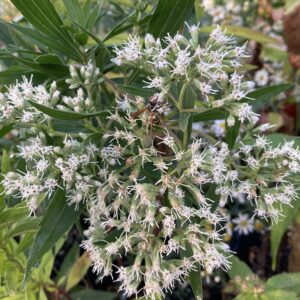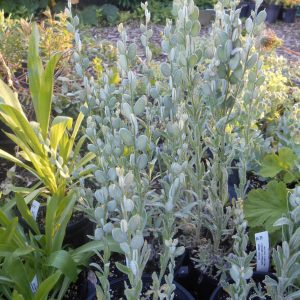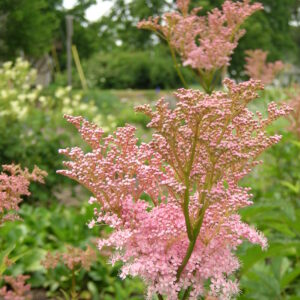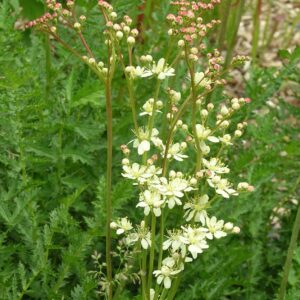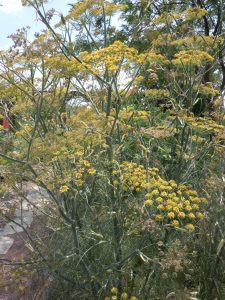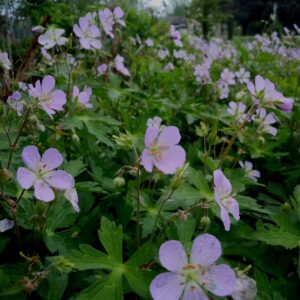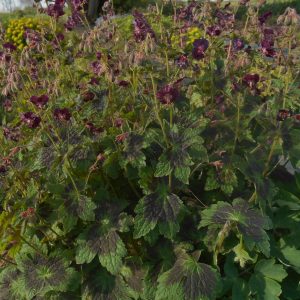Plants for Butterflies and Other Pollinators
Showing 89–96 of 223 results
-
Eupatorium sessilifolium Upland boneset Z 3-8
Showy flat-topped, white flower clusters July to September
Showy flat-topped, white flower clusters July to September
Size: 3-4’ x 12-24”
Care: Shade to part shade in moist well-drained soil to dry soil, drought tolerant
Native: most of eastern half of US, Wisconsin native but rare and endangered
Wildlife Value: Nectar attracts bees and butterflies. Food for caterpillars of several moths. Deer & rabbit resistant.Collected before 1753.
-
Fibigia clypeata Roman shields Z 5-7
Yellow spring flowers – early summer, followed by small, oval “silver dollars.”
Yellow spring flowers – early summer, followed by small, oval “silver dollars” on erect stems.
Size: 18” x 12-15”
Care: sun well-drained soil Self-seeds freely
Native: Southern Europe
Wildlife Value: source of nectar and pollen for bees and other insects
Size: Used for their ornamental seed pods. Harvest either when 1st form for fuzzy grey-green color or when mature with outer skin removed for translucent, silver shieldIn gardens before 1753.
-
Filipendula rubra Queen of the Prairie Z 3-9
Extraordinary frothy pink plumes, like cotton candy, blooming in midsummer
Extraordinary frothy pink plumes, like cotton candy, blooming in midsummer
Size: 4-6’ x 4-5'
Care: sun to part shade in moist well-drained to moist soil
Native: US East coast west to MN s to MO and NC, Wisconsin native
Wildlife Value: This creates pollen but not nectar limiting the pollinators to bees and flies (Butterflies and wasps want nectar.).Meskwaki Indians used it for heart ailments and as an aphrodisiac. Although the plant’s name has been changed five times, this was 1st described in 1768.
-
Filipendula vulgaris syn. F. hexapetala Dropwort or Meadowsweet Z 3-9
In early summer bundles of milk white ball-shaped buds and open blossoms atop clumps of finely-cut, fern-like leaves, both flowers and foliage fragrant, early to mid-summer.
OUT OF STOCK
In early summer bundles of milk white ball-shaped buds and open blossoms atop clumps of finely-cut, fern-like leaves, both flowers and foliage fragrant, early to mid-summer.
Size: 24" x 18"
Care: sun in moist to moist well-drained soil
Native: Europe, north and central Asia
Wildlife Value: attracts bees, beetles and fliesFilipendula is Latin from filum meaning thread and pendulus meaning hanging for small tubers hanging by threadlike roots. In the 1600’s Nicholas Culpepper described Meadowsweet’s medicinal uses as curing bladder problems, throat, lung diseases and “the falling sickness.” Filipendula vulgaris also remedied bloated stomachs “dissolving and breaking the wind.”
-
Foeniculum vulgaris ‘Purpureum’ Bronze fennel Z 4-9
Yellow blooms on flat-topped umbels in late spring into summer, features dusky purple, feathery, compound, aromatic purple leaves with needle-like segments.
Yellow blooms on flat-topped umbels in late spring into summer, features dusky purple, feathery, compound, aromatic purple leaves with needle-like segments.
Size: 4-5’ x 2-3’
Care: sun to part shade in well-drained soil. Drought tolerant.
Native: Mediterranean
Wildlife Value: attracts bees and birds. Nectar plant for Swallowtail butterflies. Flat-topped surface gives insects a landing pad.Ancient Egyptians used fennel as food and medicine. Considered a snake bite remedy in ancient China. During the Middle Ages it was hung over doorways to drive away evil spirits. Fennel is also associated with the origin of the marathon. Athenian Pheidippides carried a fennel stalk on his 150-mile, 2-day run to Sparta to gather soldiers for the battle of Marathon with Persia in 490 B.C. The battle itself was also reportedly waged on a field of fennel. The Gardeners Dictionary, eighth ed. 1768.
-
Gaura lindheimeri syn. Oenothera lindheimeri White gaura, Beeblossom Z 5-9
Multitudes of small white/pink. 4-petaled blossoms on wiry stems from May to October. Cut back by half in July to increase blossoms, as though the hoards are not enough.
OUT OF STOCK
Multitudes of small white/pink. 4-petaled blossoms on wiry stems from May to October. Cut back by half in July to increase blossoms, as though the hoards are not enough.
Size: 36” x 36”
Care: Full sun in well-drained to moist well-drained acidic soil
Native: Texas and Louisiana
Wildlife Value: deer & rabbit resistant. Source of pollen for bees, butterflies and hummingbirds
Awards: Royal Horticultural Society Award of Merit.Gaura is from the Greek gauros meaning superb. Collected in 1851 by German plant hunter Ferdinand Lindheimer (1801-1879) in the Texas Hill Country. Lindheimer considered the Father of Texas botany. L.H. Bailey (1913) wrote: “The best kind is Gaura lindheimeri which has white flowers of singular appearance, with rosy calyx tubes.”
-
Geranium maculatum American Cranesbill, Wild geranium, Spotted geranium Z 3-8
Saucer-shaped, five rose-pink to lilac oval petals with darker veins to the center, guiding pollinators to its nectar, surround ten upright stamens bearing yellow pollen in the center bloom in mid to late spring and early summer if cool.
Saucer-shaped, five rose-pink to lilac oval petals with darker veins to the center, guiding pollinators to its nectar, surround ten upright stamens bearing yellow pollen in the center bloom in mid to late spring and early summer if cool.
Size: 24" x 18"
Care: Full sun to part shade in moist to moist well-drained soil
Native: East North America, Wisconsin native.
Wildlife Value: Nectar and pollen source for hummingbirds, bees and butterfliesNative Americans taught colonists to use the plant to cure diarrhea, dysentery and hemorrhaging. Also used on sores, open wounds, canker sores and sore feet. The Choctaw prescribed it for venereal disease. Sent to Europe in 1732 This species collected by French planthunter André Michaux (1746-1802) who spent 11 years collecting plants in the US. Jefferson asked John Bartram to obtain seeds, 1786. Pressed specimen in Emily Dickinson’s herbarium.
-
Geranium phaeum ‘Samobor’ Mourning widow Z 4-9
Very distinctive variegated chocolate-green chevron-marked leaves. Nodding, eggplant purple saucer-shaped flowers in late spring-early summer.
Very distinctive variegated chocolate-green chevron-marked leaves. Nodding, eggplant purple saucer-shaped flowers in late spring-early summer.
Size: 12-15” x 12"
Care: part sun to shade in moist well-drained soil
Native: Croatia
Wildlife Value: Deer & rabbit resistant. Attracts butterflies and other pollinatorsIt is a natural, genetic variant found growing in damp woods in Croatia and is named for the Croatian town of Samobor where the very first ‘Samobor’ still grows. Discovered in 1990 by Elizabeth Strangman of Washfield Nursery in Kent England. OK you caught me, it’s not heirloom – this had its 33rd birthday in 2023. In three decades, it will be eligible for Social Security. It’s such a wonderful plant it’s Ok to make an occasional exception.

